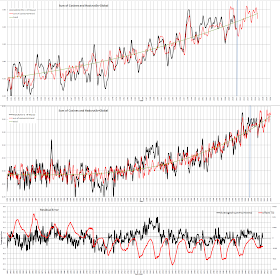Obtaining the repetitive frequencies:
Using bandpass filters set to a bandwidth of f/150 (where f is the lower frequency of the BP filter) the filter is swept from 0.5year to 150 years looking for amplitude peaks.
As each peak is found the output from the filter is compared to the output of a cosine wave set to the filter output amplitude and to the centre frequency of the filter. The cosine wave is is then phase shifted to align the two waveforms.
This is repeated for as many peaks as are found in the HADCRUT3V record. Outputs from the BP filters that fall into likely TSI frequencies 10, 11, 12, 14, 21 years have their corresponding synthesized outputs nulled. 0.5 year output is also nulled.
TSI is phase shifted, amplitude modified, then it added or subtracted from sum of cosines (shift is +48 months and is subtracted). However from the start of records to a round 1900 a lower error is provided by adding the TSI!
The remaining synthesized outputs are then summed and modified by a multiplier constant (approx 2.69) set by minimising the error between synthesized and original HADCRUT.
No low frequency peaks were found that could fit the rise in temperature. The rise is obtained by curve fitting the HADCRUT data with a 3rd order polynomial:
y = 2.40389E-07x^3 - 1.34093E-03x^2 + 2.49320E+00x - 1.54550E+03
This is added into the synthesised data to provide the output data.
Because the reconstructed data is just the sum of cosines and TSI is relatively unimportant the data can be extended to the future in this case to about 2017.
The plots show 2011 to be cooling to mid year.
The following plots show the effects of
No TSI
TSI subtracted over whole period
TSI added until 1904 and then subtracted to current date
This is a plot of the frequencies and amplitudes used to obtain these plots. Disabled frequencies are shown as Zero amplitude. The output at 11 years represents TSI amplitude
band pass filter http://www.web-reg.de/bp_addin.html
| Period years | amplitude | Phase |
| 0.501165 | 0 - artificially set to zero | 3977.413703 |
| 0.841963889 | 0.006750249 | 54.17800684 |
| 0.890040278 | 0.010820097 | 107.3740716 |
| 1.768375 | 0.006095148 | 63.60020753 |
| 1.937269444 | 0.006963534 | 46.86597827 |
| 1.992377604 | 0.005092903 | 5.83418163 |
| 2.038391667 | 0.004105465 | 40.65715905 |
| 2.107 | 0.004651939 | 23.05126836 |
| 2.264857778 | 0.007415539 | 29.18466231 |
| 2.3139375 | 0.009177612 | 69.3504266 |
| 2.541777778 | 0.006009001 | 23.33534812 |
| 2.675555556 | 0.007867544 | 52.76779754 |
| 2.745788889 | 0.004892064 | 10.93806807 |
| 2.87455 | 0.010417192 | 40.32797096 |
| 3.155483333 | 0.005246582 | 75.96412155 |
| 3.269194444 | 0.004667568 | 6.630682169 |
| 3.579391667 | 0.008309031 | 40.98807579 |
| 3.7625 | 0.008048213 | 9.685707583 |
| 3.775041667 | 0.008219473 | 29.02716352 |
| 3.990758333 | 0.005512257 | 55.81368265 |
| 4.703125 | 0.005653949 | 6.33244882 |
| 5.127033333 | 0.004919605 | 6.188780868 |
| 5.225694444 | 0.004829187 | 34.08701089 |
| 5.727361111 | 0.002816915 | 6.746840105 |
| 5.986555556 | 0.004839718 | 33.42814581 |
| 6.297588889 | 0.00394786 | 23.39636614 |
| 6.598588889 | 0.002294266 | 3.380314824 |
| 7.586036111 | 0.002836881 | 34.9110203 |
| 8.441377778 | 0.002737653 | 34.79750828 |
| 9.121972222 | 0.006211276 | 17.3232396 |
| 10.07848333 | 0 - artificially set to zero | 6.888853744 |
| TSI WAVEFORM set at 11 yrs | 0.006495 THE TSI DATA | 48 Months |
| 11.45221389 | 0- artificially set to zero | 28.41974504 |
| 12.38280556 | 0- artificially set to zero | 22.96039729 |
| 14.79916667 | 0- artificially set to zero | 16.96130996 |
| 21.17869444 | 0- artificially set to zero | 23.39280935 |
| 35.88588889 | 0.001785871 | 10.89922244 |
| 64.19661111 | 0.002785835 | 16.71200197 |
| 64.21333333 | 0.002785776 | 4.134103705 |
| 2508.333333 | 1.56572E-06 | 0.302469618 |
| 2508.333333 | 1.56572E-06 | 0.30372208 |
| 2508.333333 | 1.56572E-06 | 0.462315105 |
Problems:
Just what is the filter capability of the BandPass excel plugin? A better version is required.
Need a better trend profile than the 3rd order polynomial
Bandpass filter is not good doeas not detect longer periods - insufficient length of data
=======
Yes - I know that with enough parameters you can match anything with a sum of sines. But this plot gives a reasonable match for 160 years so a few years into the future may also be well matched!
It should also be noted that there is an underlying trend (the polynomial == GHG forcing?) which is always positive. But there are many negative slopes and zero warming areas synthesized.




Cool post, TFP.
ReplyDeleteA couple of questions:
1. What did you use for TSI?
2. Are there any albedo adjustments?
3. What frequencies did you detect?
4. Have you tried fitting the TSI against just the residuals of a linear or exponential trend?
More to do!
The table (now) above contains all the frequencies seen using this method. Obviously with only 150 years of data detecting long periods is not possible.
ReplyDeleteWhat did I use for TSI. It should have been onthe spreadsheet but isn't. I now cannot find the data I kow I was toying with the idea of interpolating Leif Svalgaards data to month periods. But I then found the data. I will continue to look.
There are no albedo adjustments
I have not tried linear+TSi or exponential+tsi. I may try this but I'm not sure what this will proove???
Do the various possible periods between 11:35 and 35:64 then come up as 0 amplitude?
ReplyDeleteI am intrigued by the 11 (solar cycle) and the 64 (which is a near miss to my best fit for sines with nls)
Enjoy!
ReplyDeletehttp://www.fel.duke.edu/~scafetta/pdf/